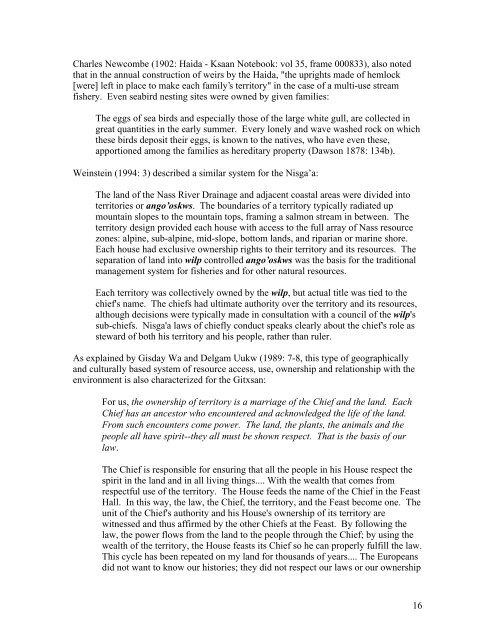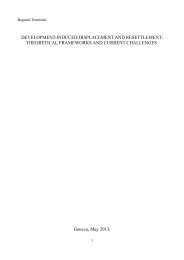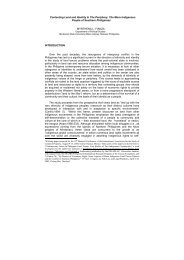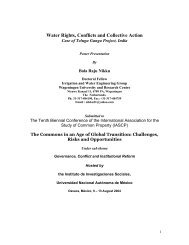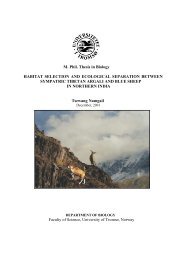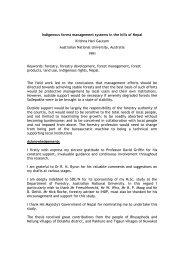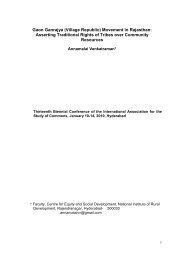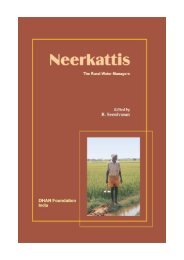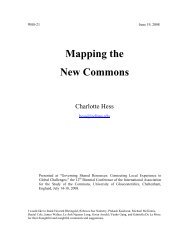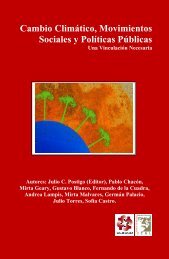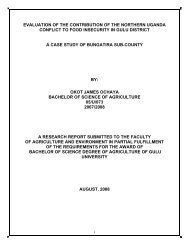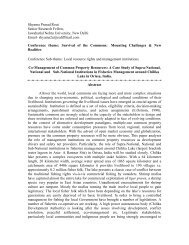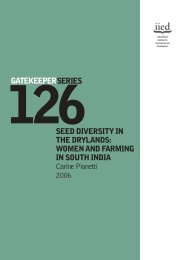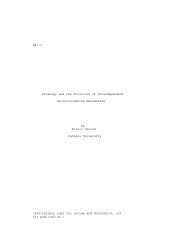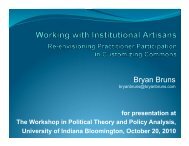Occupying the Land - Digital Library Of The Commons
Occupying the Land - Digital Library Of The Commons
Occupying the Land - Digital Library Of The Commons
Create successful ePaper yourself
Turn your PDF publications into a flip-book with our unique Google optimized e-Paper software.
Charles Newcombe (1902: Haida - Ksaan Notebook: vol 35, frame 000833), also notedthat in <strong>the</strong> annual construction of weirs by <strong>the</strong> Haida, "<strong>the</strong> uprights made of hemlock[were] left in place to make each family’s territory" in <strong>the</strong> case of a multi-use streamfishery. Even seabird nesting sites were owned by given families:<strong>The</strong> eggs of sea birds and especially those of <strong>the</strong> large white gull, are collected ingreat quantities in <strong>the</strong> early summer. Every lonely and wave washed rock on which<strong>the</strong>se birds deposit <strong>the</strong>ir eggs, is known to <strong>the</strong> natives, who have even <strong>the</strong>se,apportioned among <strong>the</strong> families as hereditary property (Dawson 1878: 134b).Weinstein (1994: 3) described a similar system for <strong>the</strong> Nisga’a:<strong>The</strong> land of <strong>the</strong> Nass River Drainage and adjacent coastal areas were divided intoterritories or ango’oskws. <strong>The</strong> boundaries of a territory typically radiated upmountain slopes to <strong>the</strong> mountain tops, framing a salmon stream in between. <strong>The</strong>territory design provided each house with access to <strong>the</strong> full array of Nass resourcezones: alpine, sub-alpine, mid-slope, bottom lands, and riparian or marine shore.Each house had exclusive ownership rights to <strong>the</strong>ir territory and its resources. <strong>The</strong>separation of land into wilp controlled ango’oskws was <strong>the</strong> basis for <strong>the</strong> traditionalmanagement system for fisheries and for o<strong>the</strong>r natural resources.Each territory was collectively owned by <strong>the</strong> wilp, but actual title was tied to <strong>the</strong>chief's name. <strong>The</strong> chiefs had ultimate authority over <strong>the</strong> territory and its resources,although decisions were typically made in consultation with a council of <strong>the</strong> wilp'ssub-chiefs. Nisga'a laws of chiefly conduct speaks clearly about <strong>the</strong> chief's role assteward of both his territory and his people, ra<strong>the</strong>r than ruler.As explained by Gisday Wa and Delgam Uukw (1989: 7-8, this type of geographicallyand culturally based system of resource access, use, ownership and relationship with <strong>the</strong>environment is also characterized for <strong>the</strong> Gitxsan:For us, <strong>the</strong> ownership of territory is a marriage of <strong>the</strong> Chief and <strong>the</strong> land. EachChief has an ancestor who encountered and acknowledged <strong>the</strong> life of <strong>the</strong> land.From such encounters come power. <strong>The</strong> land, <strong>the</strong> plants, <strong>the</strong> animals and <strong>the</strong>people all have spirit--<strong>the</strong>y all must be shown respect. That is <strong>the</strong> basis of ourlaw.<strong>The</strong> Chief is responsible for ensuring that all <strong>the</strong> people in his House respect <strong>the</strong>spirit in <strong>the</strong> land and in all living things.... With <strong>the</strong> wealth that comes fromrespectful use of <strong>the</strong> territory. <strong>The</strong> House feeds <strong>the</strong> name of <strong>the</strong> Chief in <strong>the</strong> FeastHall. In this way, <strong>the</strong> law, <strong>the</strong> Chief, <strong>the</strong> territory, and <strong>the</strong> Feast become one. <strong>The</strong>unit of <strong>the</strong> Chief's authority and his House's ownership of its territory arewitnessed and thus affirmed by <strong>the</strong> o<strong>the</strong>r Chiefs at <strong>the</strong> Feast. By following <strong>the</strong>law, <strong>the</strong> power flows from <strong>the</strong> land to <strong>the</strong> people through <strong>the</strong> Chief; by using <strong>the</strong>wealth of <strong>the</strong> territory, <strong>the</strong> House feasts its Chief so he can properly fulfill <strong>the</strong> law.This cycle has been repeated on my land for thousands of years.... <strong>The</strong> Europeansdid not want to know our histories; <strong>the</strong>y did not respect our laws or our ownership16


